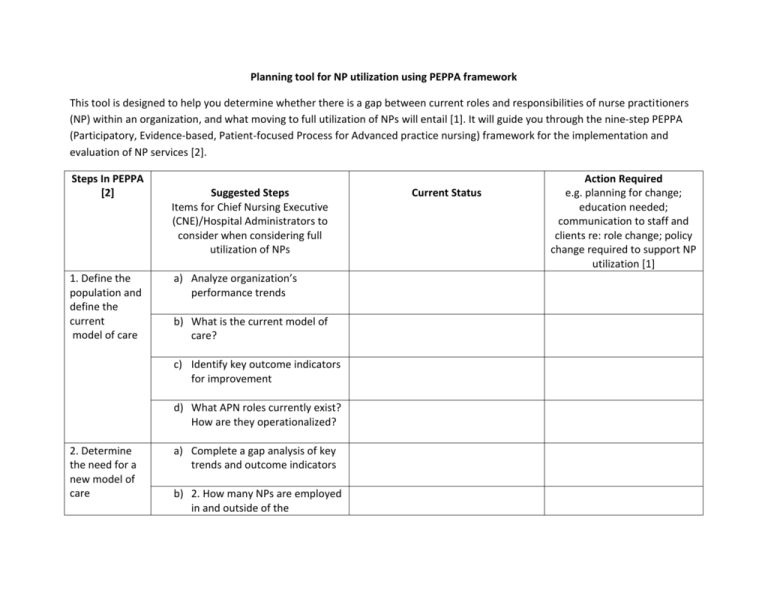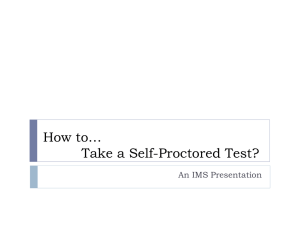NP Utilization Planning Tool: PEPPA Framework
advertisement

Planning tool for NP utilization using PEPPA framework This tool is designed to help you determine whether there is a gap between current roles and responsibilities of nurse practitioners (NP) within an organization, and what moving to full utilization of NPs will entail [1]. It will guide you through the nine-step PEPPA (Participatory, Evidence-based, Patient-focused Process for Advanced practice nursing) framework for the implementation and evaluation of NP services [2]. Steps In PEPPA [2] 1. Define the population and define the current model of care Suggested Steps Items for Chief Nursing Executive (CNE)/Hospital Administrators to consider when considering full utilization of NPs a) Analyze organization’s performance trends b) What is the current model of care? c) Identify key outcome indicators for improvement d) What APN roles currently exist? How are they operationalized? 2. Determine the need for a new model of care a) Complete a gap analysis of key trends and outcome indicators b) 2. How many NPs are employed in and outside of the Current Status Action Required e.g. planning for change; education needed; communication to staff and clients re: role change; policy change required to support NP utilization [1] organization and are to be credentialed/privileged? c) 3. Is there a process currently in place for credentialing/privileging? d) 4. Analyze potential barriers and facilitators of implementing NP admit/discharge authority 3. Identify stakeholders and recruit participants a) Develop stakeholder group (may include CNE, Medical Directors, patients, NPs, RNs, MDs and other relevant health care team members) b) Build buy-in and support for new model of NP admit/discharge authority 4.Identify priority problems and goals to improve the model of care a) Decide what area(s) of the organization or program(s) NP admit/discharge authority will begin based on organizational and gap analysis b) Identify key outcome measurements for data collection when NP admit/discharge authority begins 5. Define the new model of care and APN role a) Identify and operationalize what NP admit/discharge authority will look like (which NPs will be MRPs, shared/Collaborative, or consultative?) b) Develop and/or revise credentialing/privileging processes for implementing NP admit/discharge authority 6. Plan implementation strategies a) Develop implementation plan for NP admit/discharge authority b) Develop necessary policies/procedures and reporting structures to support NP authority c) Consult and provide education across the organization where NP admit/discharge authority will occur 7. Initiate APN role implementation plan a) Implement NP admit/discharge authority plan b) 2. Provide ongoing education and support as required and 8. Evaluate the APN role and new model of care address concerns/questions as they arise a) Conduct frequent meetings and solicit ongoing feedback to identify continued barriers and facilitators for NP admit/discharge authority b) Implement outcome measurement of key indicators to be achieved 9. Long-term monitoring of the APN role and model of care a) Analyze outcome measurements of identified key indicators identified (may include patient satisfaction, NP/MD satisfaction, length of stay etc.) b) Appraise if any new innovations have come from the new model of NP admit/discharge authority c) Make appropriate changes to NP role References 1. 2. Registered Nurses' Association of Ontario. Gap analysis Tool from Primary Solutions to Primary Care: Maximizing and Expanding the Role of the Primary Care Nurse in Ontario. 2012 [cited 2015 July 24]; Available from: http://primarycaretoolkit.ca/sites/pct/files/Gap_Analysis_RNs_0.pdf. Bryant-Lukosius, D. and A. DiCenso, A framework for the introduction and evaluation of advanced practice nursing roles. Journal of Advanced Nursing, 2004. 28(5): p. 530-540.




